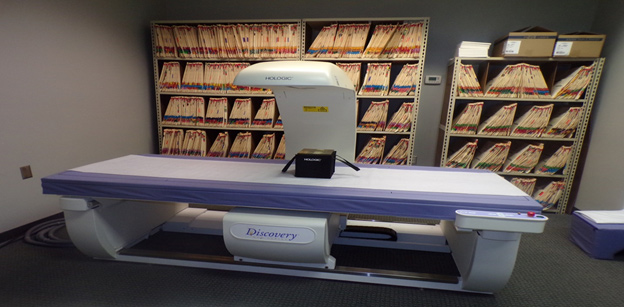Bone Densitometry

A bone mineral density or BMD test uses special low dose X-ray to measure the density of calcium and other minerals in your bones to assess bone strength. This test helps in the diagnosis of osteoporosis, a silent disease that thins and weakens bone and increases the risk of fractures.
Indications
Bone mineral density testing is recommended for the following individuals:
- Women aged 65 or older
- Men aged 70 or older
- Younger women with increased risk of osteoporosis
- Hyperparathyroidism
- Long term consumption of corticosteroids
- Family history of osteoporosis
- Chronic rheumatoid arthritis
- Chronic kidney disease
- History of fractures
Types of BMD Testing
Different techniques of measuring BMD include:
Dual-Energy X-ray absorptiometry or DEXA uses two different low dose X-ray beams to estimate BMD in the hip and spine region. It is the most accurate method of measuring BMD.
Peripheral dual-energy X-ray absorptiometry or P-DEXA is a type of DEXA test used to measure BMD in the wrist and forearm or legs. P-DEXA is a portable device which gives faster results than DEXA.
Dual photon absorptiometry or DPA uses low dose radiation to measure BMD in the hip and spine region. Scanning time is longer than with Dexa.
Ultrasound uses sound waves to measure BMD and is a quick and painless procedure without the use of radiation. It is often used on the heels as a screening test at health fairs. Further testing is required to confirm a diagnosis of osteoporosis.
Procedure
The BMD scan is conducted in a special radiology department.
- You will lie on your back on a padded table
- The radiologist will pass a scanner over your body to take X-rays of the bones. After the bones are scanned by the machine, the amount of radiation absorbed will be measured.
- The DEXA technique used to scan the hip and lower spine will take about 20 minutes. A DPA scan can take about 30 to 45 minutes to complete the test.
- Ideally, it is best to test the same bones (preferably, hip and spine bones) each time with the same BMD technique to achieve reliable results.
Results
Results of a BMD test are reported in two ways; as T-scores and as Z-scores.
Your T-score will be your BMD compared to the average score of a healthy 30-year-old. A negative value is an indication of thinner bones with low BMD, and a positive value is an indication of stronger bones. A normal T-score is greater than minus 1 (-1), whereas a T-score of minus 1 to minus 2.5 indicates osteopenia, and a score of minus 2.5 or less indicates osteoporosis.
A Z-score compares your results to other individuals of the same age, weight, ethnicity, and gender. A Z-score of less than minus 1.5 raises concern of osteoporosis due to factors other than aging.
Risks and complications
The BMD test is generally safe but involves possible risks and complications. These include:
- Exposure to radiation
- Not recommended during pregnancy due to exposure of the baby to radiation












